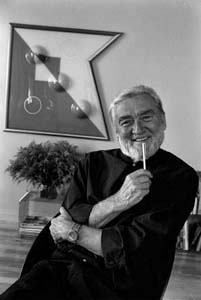This article may be in need of reorganization to comply with Wikipedia's layout guidelines .(November 2016) |
Barbara D'Arcy (1928-2012) was one of the most important visual merchandisers of the 20th century.
This article may be in need of reorganization to comply with Wikipedia's layout guidelines .(November 2016) |
Barbara D'Arcy (1928-2012) was one of the most important visual merchandisers of the 20th century.
Barbara D’Arcy was born on April 3, 1928, in Manhattan, the youngest of three children of Ida Marie and James J. D’Arcy. Her mother was an art teacher, her father a manager for a Manhattan moving and storage company. [1] Her father's job made him a discerning judge of furniture. [1]
D'Arcy attended Hunter Model School (today Hunter Elementary and High School). [2] She graduated from the College of New Rochelle. [1]
After graduating college, D'Arcy joined Bloomingdale's as a junior decorator in the fabric department in 1952. [1] In the 1950s, Bloomingdale's was moving away from its roots as a "garden variety neighborhood department store" and trying to become a higher-end retailer. [3] European furniture designers were happy to find a new market in New York and Bloomingdale's soon began creating model rooms to display the merchandise. [3]
In 1958, D'Arcy was named coordinating designer of the store's model rooms. [1] From 1958 until 1973 she designed hundreds of model rooms in themes ranging from Danish Modern to French Country [1]
Each showroom D'Arcy created was unique. She would use a few characteristic details that captured the world's attention. For example, when D'Arcy used treillage (the French word for vine arbor, latticework; a lattice or trellis), the Edwardian architectural style mixed with French style. D'Arcy was able to create a contemporary French country style through the use of all white lacquered furniture within a white octagon shaped pavilion. [4]
One of D'Arcy White's best known showrooms, called "Saturday Generation", was in collaboration with Frank Gehry. This room encompassed a warm, monastic feeling by using cardboard as the only material. At the time, the use of cardboard was a surprising yet stylish use for an old, underrated material. Its popularity was founded on the practicality of the material in combination with the modernity of the shapes. [4]
Another well-known model room was the Cave Room, a Flintstonesque room made from a frame of chicken wire and wood, sprayed with urethane foam and painted white. The furniture was built into the foam. [1]
D’Arcy was credited with creating or popularizing several styles that still resonate in the American home, including steel and glass furnishings, plaid curtains for children's rooms, and the "Country French" look. [1] [5]
D’Arcy became a merchandising executive in 1975 and she traveled the world as part of a Bloomingdale's team of design scouts. She was among the first Americans to visit the People's Republic of China on business after its relations with the United States were normalized in 1972. [1]
In the late 1970s Ms. D’Arcy directed the redesign of Bloomingdale's entire first floor, a three-year project. The redesign was completed in 1979 and the black marble and brass-look of the store has since become iconic. [1]
D'Arcy remained with Bloomingdale's until her retirement in 1995. [1] She died on May 10, 2012, in Southampton, NY, at the age of 84. [2]

Sister Parish was an American interior decorator and socialite. She was the first practitioner brought in to decorate the Kennedy White House, a position soon entrusted to French interior decorator Stéphane Boudin. Despite Boudin's growing influence, Parish's influence can still be seen at the White House, particularly in the Yellow Oval Room.

Verner Panton is considered one of Denmark's most influential 20th-century furniture and interior designers. During his career, he created innovative and futuristic designs in a variety of materials, especially plastics, and in vibrant and exotic colors. His style was very "1960s" but regained popularity at the end of the 20th century. As of 2004, Panton's best-known furniture models are still in production.

Interior design is the art and science of enhancing the interior of a building to achieve a healthier and more aesthetically pleasing environment for the people using the space. An interior designer is someone who plans, researches, coordinates, and manages such enhancement projects. Interior design is a multifaceted profession that includes conceptual development, space planning, site inspections, programming, research, communicating with the stakeholders of a project, construction management, and execution of the design.

Gwendoline Maud Syrie Maugham was a leading British interior decorator of the 1920s and 1930s who popularized rooms decorated entirely in white.

Florence Marguerite Knoll Bassett was an American architect, interior designer, furniture designer, and entrepreneur who has been credited with revolutionizing office design and bringing modernist design to office interiors. Knoll and her husband, Hans Knoll, built Knoll Associates into a leader in the fields of furniture and interior design. She worked to professionalize the field of interior design, fighting against gendered stereotypes of the decorator. She is known for her open office designs, populated with modernist furniture and organized rationally for the needs of office workers. Her modernist aesthetic was known for clean lines and clear geometries that were humanized with textures, organic shapes, and colour.
Habitat, is a brand of household furnishings in the United Kingdom and the main homewares brand within the Sainsbury's group.

The Willow Tearooms are tearooms at 217 Sauchiehall Street, Glasgow, Scotland, designed by internationally renowned architect Charles Rennie Mackintosh, which opened for business in October 1903. They quickly gained enormous popularity, and are the most famous of the many Glasgow tearooms that opened in the late 19th and early 20th century. The building was fully restored, largely to Mackintosh's original designs, between 2014 and 2018. It was re-opened as working tea rooms in July 2018 and trades under the name "Mackintosh at The Willow". This follows a trademark dispute with the former operator of The Willow Tearooms which was resolved in 2017. This name is now used at tea room premises in Buchanan Street and was also additionally used at the Watt Brothers Department Store in Sauchiehall Street, Glasgow between 2016 and its closure in 2019.

Phyllis Morris was an American furniture designer known for her colorful persona, her outspokenness on decorating and her distinctive furniture and interior designs, especially her large and highly decorative beds. She was often referred to by the media as the "designer to the stars." By the time of her death, Morris had left a mark in the world of interior design in each of the four decades since the founding of her company Phyllis Morris Originals in 1953.

The second season of Project Runway Philippines premiered on August 12, 2009, on cable network ETC and UHF station Southern Broadcasting Network. Model and actress Teresa Herrera returns as the program's host, while fashion designers Jojie Lloren and Rajo Laurel renew their mentorship and judging duties respectively, with top model and fashion columnist Apples Aberin completing the judging panel.

Jerome Ackerman (1920–2019) and Evelyn Ackerman (1924–2012) were American industrial designers who jointly contributed to the aesthetic of California mid-century modern with their ceramics, wood carvings, mosaics, textiles, and enamels in home furnishings and architectural elements. The Ackermans sold their products through their companies Jenev and ERA Industries. Evelyn was an accomplished artist and an author of books on antique toys and dolls.
Donghia is an American brand of decoration for furniture, textiles, lighting, and accessories. Italian-American interior designer Angelo Donghia founded Donghia in 1968. It is currently owned by Kravet Inc.

Angelo Donghia was an American interior designer.

Michael Taylor was an American designer best known for creating the "California Look" of interior design. One of Architectural Digest's "20 Greatest Designers of All Time” and "Interior Design Legends". Taylor was noted for his rooms of airiness and light with a prominent use of natural forms and the color white. In 1956, he founded his design company, Michael Taylor Interiors, Inc. Under Michael Taylor Designs, he manufactured his own designs and in 1985 partnered with Paul Weaver to develop and market interior and exterior furnishings to the wholesale design trade. Taylor worked continuously until his death in 1986.
William Carroll Pahlmann was a New York-based, mid-twentieth-century interior designer who popularized the eclectic style of design. The eclectic style borrowed decorative elements from different time periods and countries and often used bold color combinations, varying textures, and a mixture of antique and modern furnishings. Pahlmann employed eclectic design principles to accommodate his customers’ personal taste preferences and stressed the importance of comfort, functionality, and adaptability in his work.
Elena Karaman Karić is a Serbian interior designer, founder and chief designer of Lorca Design Interiors.
Harvey Probber was an American furniture designer who is credited with inventing sectional, modular seating in the 1940s. A "pioneer in the application of modular seating,” many of his ideas have been adopted by other designers.
Rose Cumming was a flamboyant and eccentric interior decorator whose career was based in New York.
Stephanie Kantis is an American jewelry designer based in Palm Beach, Florida.

Holly Hunt is an American designer. She is the founder and CEO of Holly Hunt Design, a company that designs, produces and showcases custom made product including indoor and outdoor furniture, lighting, rugs, textiles and leathers.
Ralph Pucci is an American mannequin designer, gallery owner and entrepreneur.
Pg. 46